NATURAL PATRIMONIES
 Ha
Long Bay
Ha
Long Bay
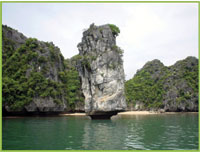 A
beautiful imposing natural scenery situated in Gulf of Tonkin,
including 1969 big and small islands stretching over 120
km of coast, total area of 1553km2 . The world-recognized
zone has area of 434km2, including 775 islands.
A
beautiful imposing natural scenery situated in Gulf of Tonkin,
including 1969 big and small islands stretching over 120
km of coast, total area of 1553km2 . The world-recognized
zone has area of 434km2, including 775 islands.
Those islands vary in shapes-unique, lively and changing
according to visitors’ angle eyes: La Vong (a fisherman
in Chinese legend), Canh Buom (sail), Cap Ga (couple of
chickens), Lu Huong (incense-burner)… Concealed in the islands
are beautiful, wondrous caverns as: Thien Cung (Celestial
Palace), Sung Sot (startled), Dau Go… This place is one
of the cradle of human with Ha Long civilization, since
the Post-Neolithic area, also assembling various forest
and sea ecological systems with thousands of species of
animals and trees, especially rare and precious ones. Ha
Long Bay was listed into world natural patrimonies on December
17, 1994 in Thailand by UNESCO.
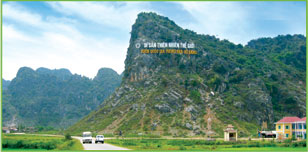
 Phong
Nha - Ke Bang Cavern
Phong
Nha - Ke Bang Cavern
At the 27th meeting of World Patrimony Committee held in
Paris (June 30 - July 5, 2003), Phong Nha - Ke Bang National
Park was acknowledged as world natural patrimony. Situated
in Ke Bang primeval forest and limestone mountain - Quang
Binh Province, Phong Nha cavern is a system of caves with
splendid, sparkling, fanciful colors of stalactites reflecting
on the longest underground river in Vietnam. Phong Nha cavern
has many branches, length up to 20km, its mouth is 20m long,
10m high. Main cave consists of 14 chambers linking by a water
gallery 1500m long; further into it still places of calcifying.
-------------------------------------------------------------------------------------------------------------------------------
Top Page
CULTURAL-HISTORICAL PATRIMONIES
 Hue
Ancient Capital
Hue
Ancient Capital
 The
old architecture community of Hue’s imperial palaces was
acknowledged as world cultural patrimony in December 1993.
This is a community of citadels and ramparts (imperial city,
royal citadel, Purple Forbidden City) and hundreds of palaces,
mausoleums, government offices, garden houses, temples,
pagodas, etc. spreading over 20,000 ha on the northern bank
of Huong River. It recorded traces of an ancient capital
of Vietnamese feudal state throughout 400 years before the
country stood French domination. This precious work included
over 100 pieces of architecture, the most famous were four
mausoleums with private manners of their kings and owners:
Gia Long-majestic, Minh Mang-imposing, Tu Duc-poetic, Khai
Dinh-magnificent.
The
old architecture community of Hue’s imperial palaces was
acknowledged as world cultural patrimony in December 1993.
This is a community of citadels and ramparts (imperial city,
royal citadel, Purple Forbidden City) and hundreds of palaces,
mausoleums, government offices, garden houses, temples,
pagodas, etc. spreading over 20,000 ha on the northern bank
of Huong River. It recorded traces of an ancient capital
of Vietnamese feudal state throughout 400 years before the
country stood French domination. This precious work included
over 100 pieces of architecture, the most famous were four
mausoleums with private manners of their kings and owners:
Gia Long-majestic, Minh Mang-imposing, Tu Duc-poetic, Khai
Dinh-magnificent.
 Hoi
An Ancient Town
Hoi
An Ancient Town
 A
busy commercial port by Thu Bon River from 16-17th century,
trading with many countries in the world: Japan, China,
Portugal, Italy, etc. Hoi An ancient town once was a prosperous
trading centre in the South East Asia, also a main station
of merchant ships of the Far East area. Therefore, Hoi An
had special cultural interference, traditional ethnic aspect
in ancient wooden houses plus imported cultural trait as
decorative multi-colored lanterns… from China, Japan… Hardly
finding somewhere in Vietnam such a calm, nostalgic atmosphere
like this.
A
busy commercial port by Thu Bon River from 16-17th century,
trading with many countries in the world: Japan, China,
Portugal, Italy, etc. Hoi An ancient town once was a prosperous
trading centre in the South East Asia, also a main station
of merchant ships of the Far East area. Therefore, Hoi An
had special cultural interference, traditional ethnic aspect
in ancient wooden houses plus imported cultural trait as
decorative multi-colored lanterns… from China, Japan… Hardly
finding somewhere in Vietnam such a calm, nostalgic atmosphere
like this.
Hoi An ancient town is also famous for thousands of shops
selling souvenirs and special foods of Quang area: Bo cakes,
Vac cakes, Cao lau, etc. With such unique value, Hoi An
ancient town was acknowledged world cultural patrimony in
December 1999 by UNESCO.
 My
Son Holy Land
My
Son Holy Land
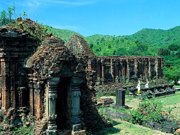 Covered
in a secret valley in Duy Phu Village, Duy Xuyen District,
Quang Nam Province, My Son Holy Land is a community of 70
towers built according to Hindu school by refined bricks
and sandstones throughout 1,000 years worshipping deities
protecting Cham kings. Each tower worshiped different deities,
kings, bearing various architectural mark and historical
period, however generally built on a four-cornered space,
divided into three parts: the base representing stable earthly
world, the body representing mysterious divine world and
the top with image of people making religious rituals, trees
and leaves, birds… The main temple worships Linga-Yoni,
representing creative power. Although passing time and war,
My Son ruins still attracts visitors for sculpture, architectural
masterpieces of a magnificent era in artistic history of
Cham people.
Covered
in a secret valley in Duy Phu Village, Duy Xuyen District,
Quang Nam Province, My Son Holy Land is a community of 70
towers built according to Hindu school by refined bricks
and sandstones throughout 1,000 years worshipping deities
protecting Cham kings. Each tower worshiped different deities,
kings, bearing various architectural mark and historical
period, however generally built on a four-cornered space,
divided into three parts: the base representing stable earthly
world, the body representing mysterious divine world and
the top with image of people making religious rituals, trees
and leaves, birds… The main temple worships Linga-Yoni,
representing creative power. Although passing time and war,
My Son ruins still attracts visitors for sculpture, architectural
masterpieces of a magnificent era in artistic history of
Cham people.
My Son Holy Land was acknowledged world cultural patrimony
in December 1999 by UNESCO.
-------------------------------------------------------------------------------------------------------------------------------------
Top Page
IMMATERIAL CULTURAL PATRIMONIES
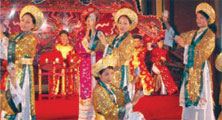
 Hue’s
Court Music
Hue’s
Court Music
Acknowledged as immaterial cultural patrimony in November
2003 by UNESCO, Hue’s Court Music is a unique traditional
kind of Vietnam, played at Court serving in rituals, meetings,
however now kept grand and small music. Hue’s Court Music
bears private trait: boisterous, lissome but strong, moving
and solemn. Spending ups and downs in the history, Hue’s
Court Music still keeps significant value: various musical
instruments, sophisticated band arrangement, unique songs,
plentiful method, profound aesthetic viewpoints …
 Western
Highland’s Gong Instrumental
Western
Highland’s Gong Instrumental
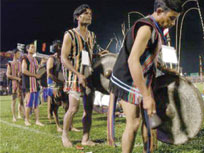 On
November 25, 2005, the “culture of gongs of Western Highland’s
peoples-Vietnam” was respectfully acknowledged as a masterpiece
of world immaterial patrimony. Gong instrumental is a unique
kind of art of ethnic peoples in the Western Highland, born
and linked with community life of the peoples. According
to research documents, gong instrumental was born so long,
maybe parallel with Dong Son culture 3,000 years ago. Almost
Highland peoples play these traditional instruments in festivals,
New Year welcome, new home celebration, harvest praying
… of villages. All gongs have round shape, the ones have
knobs called “cong”, the knobless -“ching”, radius about
20-65 cm. A set of gongs consists 6 pieces from big to small
named Vang, Rdom, Don, Thoong, Tho and Ne. In Highland peoples’bands,
each musician plays a note and a rhythm model combining
into part, melody. The Highland gong instrumental atmosphere
now are not bound within people’s villages, but spread into
the world as an immaterial unwritten masterpiece of mankind.
On
November 25, 2005, the “culture of gongs of Western Highland’s
peoples-Vietnam” was respectfully acknowledged as a masterpiece
of world immaterial patrimony. Gong instrumental is a unique
kind of art of ethnic peoples in the Western Highland, born
and linked with community life of the peoples. According
to research documents, gong instrumental was born so long,
maybe parallel with Dong Son culture 3,000 years ago. Almost
Highland peoples play these traditional instruments in festivals,
New Year welcome, new home celebration, harvest praying
… of villages. All gongs have round shape, the ones have
knobs called “cong”, the knobless -“ching”, radius about
20-65 cm. A set of gongs consists 6 pieces from big to small
named Vang, Rdom, Don, Thoong, Tho and Ne. In Highland peoples’bands,
each musician plays a note and a rhythm model combining
into part, melody. The Highland gong instrumental atmosphere
now are not bound within people’s villages, but spread into
the world as an immaterial unwritten masterpiece of mankind.

